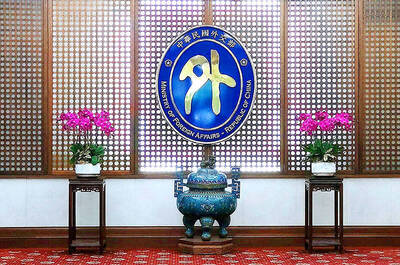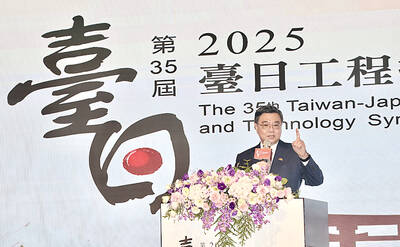The Ministry of Health and Welfare’s long-term healthcare 2.0 project has grown to serve nearly four times the number of people it handled when it started five years ago, it told the Cabinet yesterday.
The program is serving 470,000 people, or 3.8 times more than in 2017, while its coverage has surged by more than 300 percent to cover 67.03 percent of the nation and its budget has increased to NT$60.7 billion (US$2 billion) since 2016, it said.
A Taiwan Marketing Research poll, commissioned by the ministry, showed that more than 90 percent of respondents over three consecutive years said they were satisfied with the program and how it alleviated stress for people caring for those with long-term illnesses.

Photo: CNA
The program received a 97.6 percent satisfaction rating last year, demonstrating that the public supports the initiative, the ministry said.
Since its inception, the program’s main goal has been to establish at-home, communal or stay-over healthcare for people who require long-term care, establish payment schemes for workers, guarantee wages for long-term healthcare workers, increase service coverage, and develop measures to prevent or slow the loss of cognitive abilities among older people.
The program provides care through three types of centers: Category A is comprised of communal integrative service centers, category B are composite service centers and category C consists of front-end care centers.
Premier Su Tseng-chang (蘇貞昌) said that the number of service locations across all three categories exceeded 11,000 nationwide, while the “one day care center per school area” project has also grown to 760 centers, with the two combining for a total national coverage rate of 65 percent.
Su has instructed the ministry to continue to improve the initiative and said he would ask agencies such as the Ministry of Labor, the Ministry of Education, the Ministry of Finance, the Ministry of Economic Affairs and the Financial Supervisory Commission to help with the program.
The health ministry said it wants the program to change the public’s perception of long-term healthcare, moving from all-day and one-on-one service models to daycare centers where a few workers can aid many people, or to a small-scale multifunctional family care service model.
The ministry is encouraging people to interact more with professional care workers and help “train” people to take more responsibility in caring for themselves to reduce their need for full-time care.

The Ministry of Foreign Affairs (MOFA) yesterday voiced dissatisfaction with the Comprehensive and Progressive Agreement for Trans- Pacific Partnership (CPTPP), whose latest meeting, concluded earlier the same day, appeared not to address the country’s application. In a statement, MOFA said the CPTPP commission had "once again failed to fairly process Taiwan’s application," attributing the inaction to the bloc’s "succumbing to political pressure," without elaborating. Taiwan submitted its CPTPP application under the name "Separate Customs Territory of Taiwan, Penghu, Kinmen and Matsu" on Sept. 22, 2021 -- less than a week after China

ALIGNED THINKING: Taiwan and Japan have a mutual interest in trade, culture and engineering, and can work together for stability, Cho Jung-tai said Taiwan and Japan are two like-minded countries willing to work together to form a “safety barrier” in the Indo-Pacific region, Premier Cho Jung-tai (卓榮泰) yesterday said at the opening ceremony of the 35th Taiwan-Japan Modern Engineering and Technology Symposium in Taipei. Taiwan and Japan are close geographically and closer emotionally, he added. Citing the overflowing of a barrier lake in the Mataian River (馬太鞍溪) in September, Cho said the submersible water level sensors given by Japan during the disaster helped Taiwan monitor the lake’s water levels more accurately. Japan also provided a lot of vaccines early in the outbreak of the COVID-19 pandemic,

Kaohsiung Mayor Chen Chi-mai (陳其邁) on Monday announced light shows and themed traffic lights to welcome fans of South Korean pop group Twice to the port city. The group is to play Kaohsiung on Saturday as part of its “This Is For” world tour. It would be the group’s first performance in Taiwan since its debut 10 years ago. The all-female group consists of five South Koreans, three Japanese and Tainan’s Chou Tzu-yu (周子瑜), the first Taiwan-born and raised member of a South Korean girl group. To promote the group’s arrival, the city has been holding a series of events, including a pop-up

A home-style restaurant opened by a Taiwanese woman in Quezon City in Metro Manila has been featured in the first-ever Michelin Guide honoring exceptional restaurants in the Philippines. The restaurant, Fong Wei Wu (豐味屋), was one of 74 eateries to receive a “Michelin Selected” honor in the guide, while one restaurant received two Michelin stars, eight received one star and 25 were awarded a “Bib Gourmand.” The guide, which was limited to restaurants in Metro Manila and Cebu, was published on Oct. 30. In an interview, Feng Wei Wu’s owner and chef, Linda, said that as a restaurateur in her 60s, receiving an